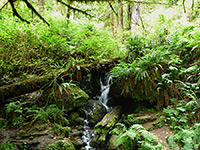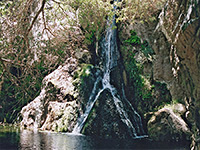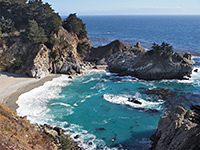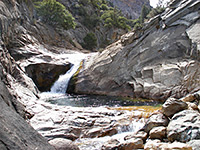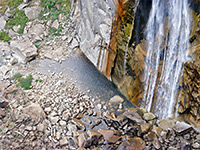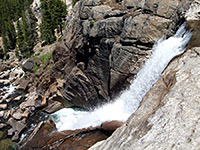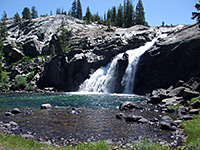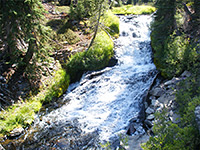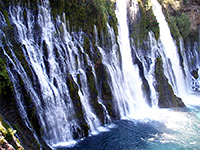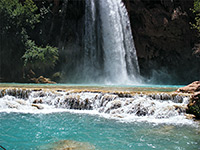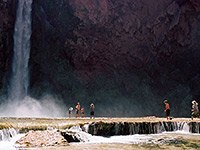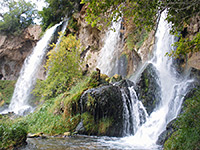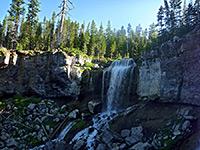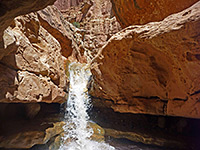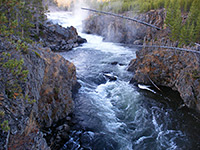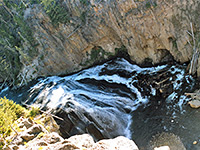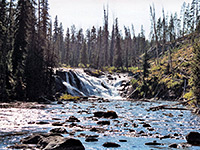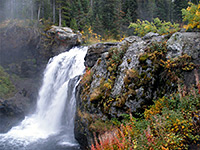Waterfalls tend to occur in the mountains, and California is no exception, as most are found in the Sierra Nevada or the Cascade Range and its wooded foothills. Those in other regions include Trillium Falls in Redwood National Park, Darwin and Willow Falls in Death Valley National Park, and McWay Falls in Julia Pfeiffer Burns State Park, on the Big Sur coast - this latter is the only coastal waterfall in the state. The beach it cascades into is out of bounds to the public, but the falls can be viewed from a short overlook trail.
In the Sierras, all four NPS units have waterfalls, most far in the backcountry but others closer, like Ella Falls, Mist Falls, Roaring River Falls and Sheep Creek Cascade, all in Kings Canyon National Park, Tokopah Falls in Sequoia National Park, and Rainbow Falls just outside Devils Postpile National Monument.
Yosemite National Park is particularly famous for its waterfalls and the major ones are as follows:
The Cascade Range begins north of the Sierra Nevada, and one of the most popular areas is Lassen Volcanic National Park, which as well as fascinating geothermal features and volcanic remains has a small selection of easily reached falls and cascades, including Mill Creek, Kings Creek and Hat Creek. Perhaps the most unusual waterfall in California is found along Burney Creek, between Lassen and Redding, contained within MacArthur-Burney Falls State Park - here the creek flows over a basalt cliff forming an elongated curtain of water, with dozens of separate columns.
Arizona is not particularly well known for waterfalls, but the state does contain three of the most beautiful anywhere, albeit somewhat damaged after a huge flash flood several years ago - these are Havasu, Mooney and Beaver, near the roadless village of Supai in the Havasupai Indian Reservation, bordering the Grand Canyon. They may be reached by an all day hike, a mule ride or a helicopter journey. Unlike these three, many of Arizona's waterfalls are seasonal and flow only during times of high rainfall, such as Grand Falls (the largest in the state), along the Little Colorado River, reached only by a long drive on unpaved roads. Three other waterfalls in Arizona, all quite different, are below Arizona Hot Springs in Lake Mead National Recreation Area, near the bridge in Tonto National Bridge State Park, and along Bear Canyon (Seven Falls), in the mountains north of Tucson.
There is one Colorado state park featuring a waterfall - Rifle Falls, located in an otherwise rather nondescript region of valleys and low mesas northwest of Glenwood Springs. Here, the water of a small creek splits into three channels, each falling over a travertine cliff. Most other waterfalls in the state are found in the Rocky Mountains, such as Bridalveil Falls near Telluride, in the San Juan range.
South Idaho is home to Mesa Falls, Texas also has a waterfall based state park (Pedernales Falls), in the Hill Country, while in New Mexico, falls tend to be concentrated in the northern mountains, such as Soda Falls, along the Jemez River in the Jemez Mountains, and Frijoles Falls in Bandelier National Monument. The densely forested hills of Oregon contain many waterfalls, most of which are little-visited, but two in national preserves are Vidae Falls along the loop drive in Crater Lake National Park, and Paulina Creek Falls by the entrance to Newberry National Volcanic Monument.
There are numerous waterfalls in Utah, both in the mountains and in the drier lands of the Colorado Plateau, and some of the most impressive of these occur in the narrow canyons in and around Zion National Park, such as Kanara Creek, Water Canyon, Left Fork of North Creek (the Subway), Orderville Canyon and Spring Hollow. Bryce Canyon National Park includes Mossy Cave Falls along Tropic Ditch, while Capitol Reef National Park has an unnamed but popular (though artificially-created) waterfall along the Fremont River right next to Highway 9, and several cascades along Sulphur Creek, accessed by a primitive trail. Many visitors to Grand Staircase-Escalante National Monument take the easy paths to Upper and Lower Calf Creek Falls, starting at trailheads along Highway 9 east of Escalante, while in the vast backcountry are several others such as Kitchen Falls. Although quite plentiful, waterfalls in the three main mountain ranges of Utah (Wasatch, Uinta, Pahvant) are not particularly well known or easy to reach; perhaps the most visited is Bridal Veil Falls along the Alpine Loop Road.
The spectacular mountains of Grand Teton National Park in Wyoming include many cascades but only one named waterfall - this is Hidden Falls, towards the lower end of Cascade Canyon. In contrast, Yellowstone National Park has many dozens, more even than Yosemite, and despite the majority being rather small, they have a great variety of shapes and surroundings. Those reached by trails are the following:
In the Sierras, all four NPS units have waterfalls, most far in the backcountry but others closer, like Ella Falls, Mist Falls, Roaring River Falls and Sheep Creek Cascade, all in Kings Canyon National Park, Tokopah Falls in Sequoia National Park, and Rainbow Falls just outside Devils Postpile National Monument.
Yosemite National Park is particularly famous for its waterfalls and the major ones are as follows:
- Bridalveil Fall (620 feet) - a popular waterfall on the south side of Yosemite Valley, reached by a very short trail
- Chilnualna Falls (690 feet) - the highest waterfall outside Yosemite valley, 4.1 miles by trail from Wawona village
- Illilouette Fall (370 feet), along the Panorama Trail from Glacier Point - the least visible waterfall around Yosemite Valley
- Nevada (594 feet) and Vernal (317 feet) falls, along the Merced River at the east end of Yosemite Valley, via the Mist Trail
- Rancheria Falls (a series of cascades), Tueeulala Fall (880 feet) and Wapama Fall (1,400 feet), all in Hetch Hetchy Valley
- Ribbon Fall (1,610 feet), on the south side of Yosemite Valley, just east of Bridalveil Fall. The highest in Yosemite Valley, but quite hidden, not reached by a trail, and flowing properly for just a few months of the year
- Sentinel Falls - a long series of steep cascades on the south side of Yosemite Valley, flowing for just a few months in spring/summer
- Tuolumne Fall, White Cascade, California Fall, LeConte Fall and Waterwheel Fall, along the Glen Aulin Trail in the Tuolumne Meadows area - the last three in the upper end of the Grand Canyon of the Tuolumne
- Upper and Lower Yosemite Fall; 1,430 feet and 320 feet respectively, the most well known and visible falls in Yosemite Valley
Arizona is not particularly well known for waterfalls, but the state does contain three of the most beautiful anywhere, albeit somewhat damaged after a huge flash flood several years ago - these are Havasu, Mooney and Beaver, near the roadless village of Supai in the Havasupai Indian Reservation, bordering the Grand Canyon. They may be reached by an all day hike, a mule ride or a helicopter journey. Unlike these three, many of Arizona's waterfalls are seasonal and flow only during times of high rainfall, such as Grand Falls (the largest in the state), along the Little Colorado River, reached only by a long drive on unpaved roads. Three other waterfalls in Arizona, all quite different, are below Arizona Hot Springs in Lake Mead National Recreation Area, near the bridge in Tonto National Bridge State Park, and along Bear Canyon (Seven Falls), in the mountains north of Tucson.
There is one Colorado state park featuring a waterfall - Rifle Falls, located in an otherwise rather nondescript region of valleys and low mesas northwest of Glenwood Springs. Here, the water of a small creek splits into three channels, each falling over a travertine cliff. Most other waterfalls in the state are found in the Rocky Mountains, such as Bridalveil Falls near Telluride, in the San Juan range.
South Idaho is home to Mesa Falls, Texas also has a waterfall based state park (Pedernales Falls), in the Hill Country, while in New Mexico, falls tend to be concentrated in the northern mountains, such as Soda Falls, along the Jemez River in the Jemez Mountains, and Frijoles Falls in Bandelier National Monument. The densely forested hills of Oregon contain many waterfalls, most of which are little-visited, but two in national preserves are Vidae Falls along the loop drive in Crater Lake National Park, and Paulina Creek Falls by the entrance to Newberry National Volcanic Monument.
There are numerous waterfalls in Utah, both in the mountains and in the drier lands of the Colorado Plateau, and some of the most impressive of these occur in the narrow canyons in and around Zion National Park, such as Kanara Creek, Water Canyon, Left Fork of North Creek (the Subway), Orderville Canyon and Spring Hollow. Bryce Canyon National Park includes Mossy Cave Falls along Tropic Ditch, while Capitol Reef National Park has an unnamed but popular (though artificially-created) waterfall along the Fremont River right next to Highway 9, and several cascades along Sulphur Creek, accessed by a primitive trail. Many visitors to Grand Staircase-Escalante National Monument take the easy paths to Upper and Lower Calf Creek Falls, starting at trailheads along Highway 9 east of Escalante, while in the vast backcountry are several others such as Kitchen Falls. Although quite plentiful, waterfalls in the three main mountain ranges of Utah (Wasatch, Uinta, Pahvant) are not particularly well known or easy to reach; perhaps the most visited is Bridal Veil Falls along the Alpine Loop Road.
The spectacular mountains of Grand Teton National Park in Wyoming include many cascades but only one named waterfall - this is Hidden Falls, towards the lower end of Cascade Canyon. In contrast, Yellowstone National Park has many dozens, more even than Yosemite, and despite the majority being rather small, they have a great variety of shapes and surroundings. Those reached by trails are the following:
- Blacktail Deer Creek Falls - small cascade over a cliff of columnar lava
- Cascades of the Firehole - on the Firehole River south of Madison, next to the Grand Loop Road
- Belcher Falls, Cave Falls, Colonnade Falls, Iris Falls, Ragged Falls and Twister Falls - along the Belcher River in the southwest corner of the park
- Crystal Falls - at the lower end of Cascade Creek, which joins the Yellowstone River between Upper and Lower Yellowstone Falls
- Dunanda Falls and Silver Scarf Falls - along Boundary Creek in the southwest corner of the park
- Fairy Falls - tall, narrow waterfall, along the path to Imperial Geyser at the edge of Midway Geyser Basin
- Fern Cascades - steep incline along Iron Spring Creek, southwest of Old Faithful; viewed via a 3 mile loop hike
- Firehole Falls - on the Firehole River one mile south of Madison
- Gibbon Falls - along the Gibbon River east of Madison Junction
- Kepler Cascades - on the Firehole River south of Old Faithful
- Lewis Falls - on the Lewis River just south of Lewis Lake
- Lost Creek Falls - in a narrow, wooded canyon behind Roosevelt Lodge, near Tower Junction
- Moose Falls - 30 foot waterfall along Crawfish Creek, a tributary of the Lewis River
- Mystic Falls - dramatic falls in a narrow ravine, next to some hot springs, reached by a short hike from Biscuit Basin
- Osprey Falls - 150 foot waterfall along the Gardner River, close to the unpaved Bunsen Peak Road (foot travel only)
- Rustic Falls - south of Mammoth along Glen Creek, in Golden Gate Canyon
- Silver Cord Cascade - narrow chute of water, 1,000 feet high, on the south side of the Grand Canyon of the Yellowstone. Viewed from afar along the Seven Mile Hole Trail, or close up (only the top) via a trail from Point Sublime
- Terraced Falls - along Falls River near the south edge of the park, reached by a short trail starting near Grassy Lake Reservoir
- Tower Falls - 132 foot waterfall along the Grand Loop Road, framed by narrow tufa spires
- Undine Falls - 60 foot waterfall on Lava Creek, right beside the Grand Loop Road
- Union Falls - along Mountain Ash Creek, a remote location in the southwest corner of the park
- Virginia Cascade - along the Gibbon River, east of Norris Geyser Basin
- Wraith Falls - pretty cascade along Lupine Creek, reached by a 0.3 mile trail
- Yellowstone Falls, Upper and Lower - the most spectacular in the park, along the Yellowstone River at the start of its Grand Canyon
All Contents © Copyright The American Southwest | Comments and Questions | Contribute | Affiliate Marketing Disclosure | Site Map
